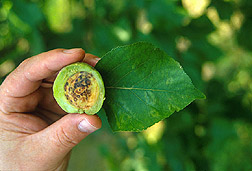Faster Detection of Plum Pox Virus
|
||
|
Scientists with the Agricultural Research Service have developed techniques that not only confirm the presence of plum pox virus (PPV), but also identify its severe and less virulent strains.
PPV infects stone fruits, such as plums, apricots, peaches, and nectarines, as well as almonds. It produces blemished, misshapen fruit and can cause fruit to drop prematurely from the tree. It can even keep a tree from bearing any fruit at all. Determining the origin of plum pox virus is a critical step in eradicating this emerging disease that now threatens the $1.3 billion U.S. stone fruit industry. The challenge lies in being able to distinguish different serotypes, or strains, of the virus. This knowledge can help researchers determine the severity of infection on different tree species and provide clues to its origin and mode of transmission. While stone fruits have been in the United States for centuries, PPV has not. It was first detected in 1999 on peaches grown in Adams County, Pennsylvania. Before that, it was not known to occur in North America at all. Therefore, any PPV infestation represents a major threat to everyone involved in stone fruit production. ARS researchers in the Floral and Nursery Plants Research Unit at the U.S. National Arboretum in Washington, D.C., led by plant pathologist John Hammond, and working with colleagues at the University of Agriculture in Vienna, Austria, have developed a new way to detect and identify the virus by using a technique called polymerase chain reaction (PCR). "Previously available serological methods sometimes lack sensitivity of detection or strain specificity," says Hammond. "And biological testing by grafting onto indicator species is slow and cannot differentiate PPV strains by serotype." PCR, on the other hand, is faster and far more specific. PCR exponentially multiplies the target molecules in the virus' nucleic acid, making enough DNA copies to be analyzed. ARS researchers and their Austrian colleagues have developed PCR primers that initiate this DNA replication. The results enable the detection of all PPV strains in a sample. The scientists then combined PCR with a method called restriction fragment length polymorphism. This technique uses special enzymes to identify DNA fragments unique to each strain. The variation in the size of these fragments helps researchers differentiate strains of PPV. "The ability to distinguish between different isolates of the same serogroup is important because it allows us to track the origin of an infection," says Hammond. "For example, if an orchard is found to be infected, the source might be the mother trees used for propagation, aphids from a neighboring orchard, or weed hosts of the virus." Distinguishing PPV serotypes may also help researchers correlate a particular strain with its ability to infect a specific type of host plant. Some strains of PPV may infect a tree easily, while others can do so only with great difficulty. Other researchers have developed PCR methods that can differentiate some PPV serotypes but not isolates within a single serotype, Hammond says. "The distinction may indicate that the tree has been infected for a long time and that variants have begun to appear. Or it could be that the tree has been infected on multiple occasions and from different sources," says Hammond. This knowledge is key to checking the spread of the disease and eradicating it from infected areas.—By Jesús García,Agricultural Research Service Information Staff. This research is part of Plant Diseases, an ARS National Program (#303) described on the World Wide Web at http://www.nps.ars.usda.gov. John Hammond is in the USDA-ARS Floral and Nursery Plants Research Unit, Building 010A, Room 242, Beltsville, MD 20705; phone (301) 504-5313, fax (301) 504-5096. |
|
|
"Faster Detection of Plum Pox Virus" was published in the November 2000 issue of Agricultural Research magazine. |
||







